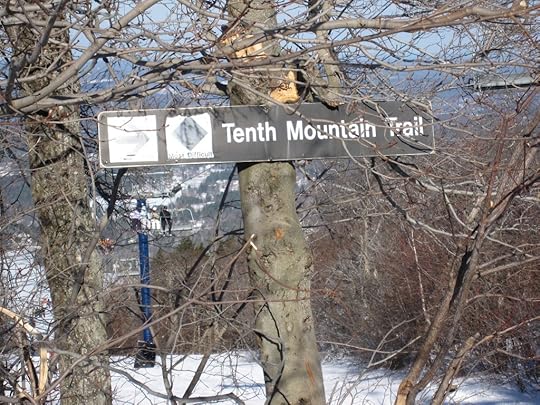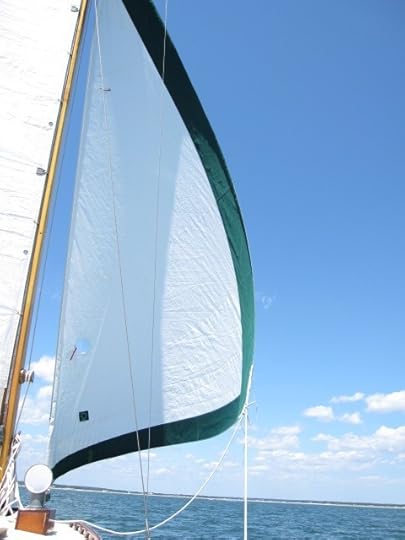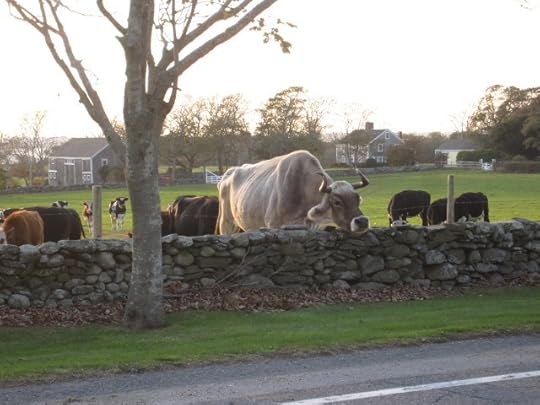The Last Run
(Winter, it will be soon on its way.)
In New England, the sails are now coming off, the masts lowered, the anchors stowed as one more season on the water ends. Soon, the skis will come out of the basement and the winter sky will offer night watchers glorious evenings, but there is no mistaking the end of the boating season. So with this as a backdrop I recently took my last sail of the season – an outing that's akin to the last run of a day on the slopes. Such an idyllic vision. Idyllic but for the fact that October's last run on the water was unfortunately the equivalent of one of those thigh burning hellish rides through an icy mogul field.
My account of this final sail starts the way every sailing story begins – you might have heard the adage, you can tell a sailing story from a fairy tale because one starts with "once upon a time" while the other begins with "no shit, there I was." So, no shit, there I was, sailing out of Westport. The sun bright, the wind honking, and only two other boats on the water: one, a big powerboat returning to port, the other, a fool like me, headed out. The wind, as it can be this time of year, was from the northwest. I was on an angle of sail that put the breeze behind me for a nice run under the genoa. The perfect end to the season.
As I merrily hopped along the waves heading south, further and further from land, the wind began stirring up the waves and even more so as I went toward the center of Buzzards Bay, a body of water known for its malicious chop. Once I was three miles or so from shore the waves grew steep, as in five-plus footers that stack right next to each other and hit you bam, bam, bam. (For those of you unaccustomed to boating, an estimated measurement of waves can be achieved by viewing the crest (top) and trough (bottom) to gauge the distance from bottom to top, which is the face of the wave. To calculate wave height, you take this figure and multiply by two or three in order to add a sense of what it was really like being out there. Lastly, if needed, round down to a more reasonable figure in cases where your calculations create an obvious overstatement. The resulting figure is your wave height.) But anyways, like I said, there I was, the waves now building up. Fortunately, our old boat is good in a sea so I wasn't worried at all about these ten-footers, errr, five-foot, waves. It was, however, time to get back home, so I headed up close to the wind, keeping my speed, and I then began to tack.
I pushed the tiller over hard and the boat began to turn until gradually the turning motion slowed. I now found myself headed into the wind, which had shifted to the west. Tacking with only a headsail can cause this challenge. But, determined, I kept the tiller over hard because I thought that one of those darn waves would slam hard into me and I could complete the tack and be able to head home. It didn't. Instead, the boat pointed into the wind and came to a standstill while the sail slapped wildly back and forth in what was now a hounding wind. In defeat, I turned the tiller back to head further out to sea, but somehow, the port sheet – the rope that controls the sail – wrapped around one of the big dorade vents up forward on the cabin top.
(Here's a good look at one of the dorade vents, this one on the starboard side, the photo taken on a pleasant, unusually flat, day.)
Alone on the boat, alone the on the water, I had no choice but to go forward in this twelve five foot sea, I mean five-foot sea, to free the line before it ripped the vent off the deck. With one hand on the grab rail I unwrapped the sheet and hurried back to the cockpit. Maybe I'll just sail to Cuttyhunk and stay overnight, I thought. Instead, I was more pragmatic – I started the engine, determined that I would be able to come about even if I needed the help of a diesel. I then began the process again, the tiller over.
The chances of looping that sheet around the vent a second time had to have been a remote statistical probability, I mean way less than the chances of Brett Favre getting an I-phone under the Christmas tree, but that's what happened. Except, this time the port and starboard sheets then wrapped around each other in a mini birds nest that resembled the spool of a fishing reel after a bad cast. So up again I went and this time I had to use both hands to straighten out the sheets, meaning that I wasn't holding onto the rocking boat with anything other than the soles of my Sperry topsider feet.
Now, the reader might remember that earlier this summer I wrote of a famed boat designer who fell off his boat while he was alone at sea. Funny how that same thought came to me as I climbed up onto the deck. But I made it. With the lines untangled I returned to the cockpit, tacked the bow around, and steered the boat home.
Thus the season was closing as I sailed for home, once again on a howling wind. And as I turned toward the entrance of the Westport River, facing the westerly wind, I furled the foresail, turned on the diesel, and steered for the mooring. Click, click, click, click, click went my trusty 3 cylinder Yanmar diesel. Click, click, click, click, click, click…STOP.
The engine, which had been reliable all year, crapped out. Up again to the deck I went, this time throwing the anchor. But what happened next is a story is for another day and in any event I got home safely without damage or loss. And at the mooring I sat back, the last run of 2010 a chapter now written.
(Even the local animals are fretting the passage of summer.)






